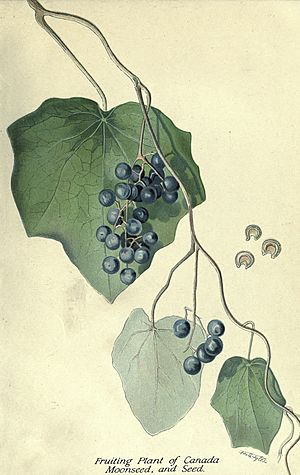Faith Fyles facts for kids
Quick facts for kids
Faith Fyles
|
|
|---|---|

Fyles in December 1913
|
|
| Born | September 30, 1875 Cowansville, Quebec, Canada
|
| Occupation | Botanical artist |
Faith Fyles (1875–1961) was a talented artist who became the first botanical artist for the Canadian federal government. She worked in the Department of Agriculture, which is now called Agriculture and Agri-Food Canada. Her amazing work helped expand the collection of dried plant specimens (called a herbarium) in Ottawa.
Biography
Faith Fyles was born on September 30, 1875, in Cowansville, Quebec, Canada. She was one of ten children. Her father, Reverend Dr. Thomas Fyles, was an English Anglican priest. He moved to Canada from England to start churches. As a hobby, he loved to study and draw insects, which is called entomology.
Faith was a very bright student. She graduated from high school with top marks. She then went to McGill University on a special scholarship. In 1905, she earned her Bachelor of Arts degree. She studied with Professor Carrie Derick, who was also a remarkable woman botanist. Professor Derick likely inspired Faith to work with plants.
After university, Faith spent a year studying the plants of Québec with her father. She also took art classes as part of the Quebec Studio Club. For six years, she taught at schools like Dunham Ladies College and Bishop Strachan School in Toronto. Then, in 1909, she spent a year traveling and studying art in Europe. She visited London and Paris, and also took trips to Spain and Italy.
Like her father, Faith was an active member of the Ottawa Field Naturalists Club. She served on committees and wrote articles for their publications and other journals.
Career
In 1909, Faith's family moved to Hull, Quebec. She got a job as an assistant seed analyst in the Department of Agriculture in Ottawa. This job was often given to women because it involved very detailed and patient work.
Two years later, Faith moved to the Botany Division at the Central Experimental Farm. She became an assistant botanist and was put in charge of the Arboretum. An Arboretum is a special garden where many different kinds of trees and shrubs are grown for study. It was unusual for the government to hire women as professional botanists back then. Some people think her father's connections or her former professor's influence might have helped her get the job. Also, she was 36, so people thought she was less likely to leave for marriage and a family.

As an assistant botanist, Faith labeled the trees, shrubs, and herbaceous (non-woody) perennials in the Arboretum. She also identified many plants that were sent to the division or collected by them. She even offered to draw plant specimens in her free time.
On July 11, 1914, Faith traveled across western Canada. Her goal was to collect different types of weeds. She collected over 800 specimens of 44 different weed species. She pressed, dried, and sent them back to Ottawa. Her first publication was in 1914, where she wrote the 'Systematic Botany' chapter in the Report of the Dominion Botanist. In 1914, Faith also traveled through Western Canada to prepare a special booklet. It was called Principal Poisonous Plants of Canada. She illustrated this bulletin with her own paintings and sketches. Her drawings helped farmers identify harmful weeds. She also worked on other publications, like the Wild Rice Bulletin in 1920. Her work also helped expand the herbarium.
During World War I, Faith researched a fungal disease that affected wild rice. This disease was called ergot. She discovered that the wild rice fungus was a completely new species. She officially described it in her wild rice bulletin in 1920. That same year, she also published her bulletin on poisonous plants. This bulletin also mentioned the wild rice ergot, which is now known as Claviceps zizaniae.
In 1920, Faith became the first artist hired by the Horticulture division. She worked under William Tyrrell Macoun. Her paintings were important because they showed the true color and details of plant specimens. This was especially helpful for studying and documenting different types of fruit, vegetables, and seeds. Her watercolor paintings were used in publications like Cultivation of the Apple in Canada and The Raspberry and its Cultivation in Canada.
In 1931, Faith had to retire due to poor health. However, she continued to paint using oils, pastels, and watercolors. For twenty years, she had shown her artwork in Royal Canadian Academy of Arts exhibitions. Her art showed her love for nature's beauty, especially plants and flowers. She also held her own exhibitions. For example, in 1924, she sold 17 of her 36 paintings at an exhibition in Ottawa. One painting was bought by Lady Byng, who was the wife of the Governor General of Canada. Lady Byng later asked Faith to paint scenes from her garden.
Faith Fyles passed away in Ottawa in 1961. She is buried with her parents in section 40 of Beechwood Cemetery.

